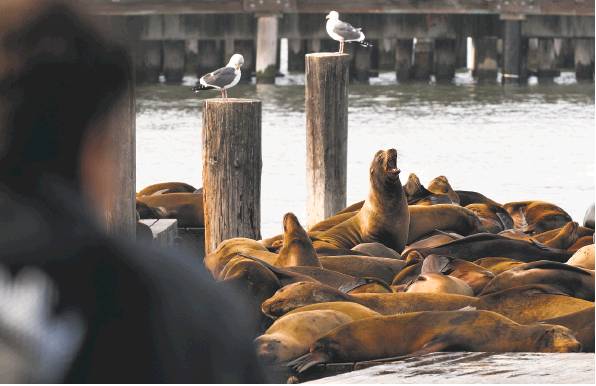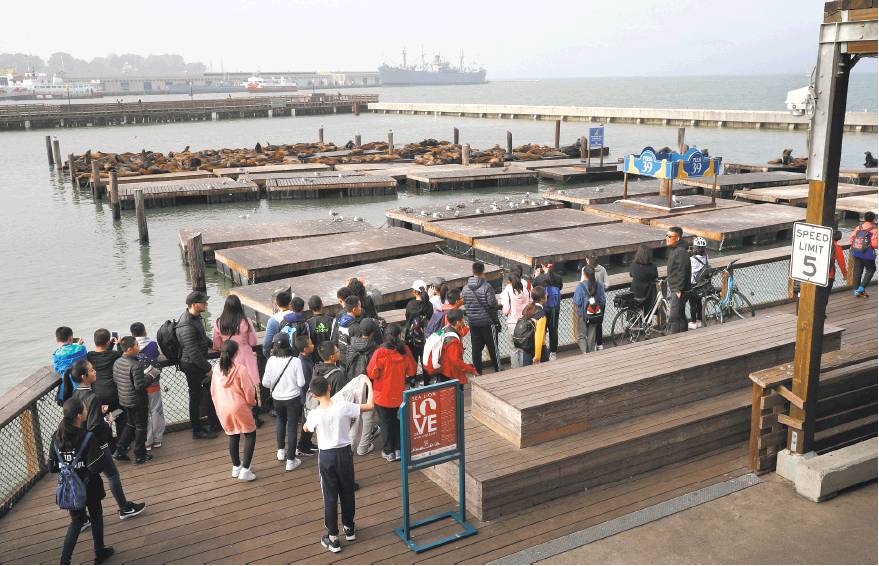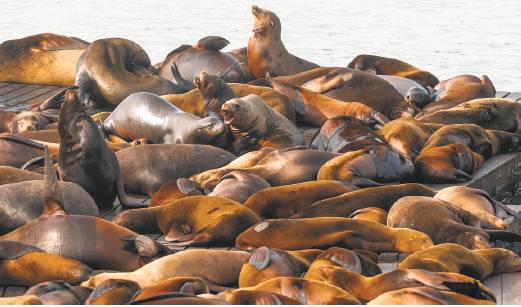Sea lions are back, scientists confirm
By Peter Fimrite
Fishermen and swimmers sure have seen a lot of sea lions — some of them snatching salmon off lines or nipping freestylers in the bay — but a study published Wednesday proves the blubbery pinnipeds are, in fact, all over the place.
The sea lion population has not only rebounded after a series of catastrophes — including a lack of food and algae poisonings — but the approximately 250,000 sea lions now living along the California coast also have reached what scientists say is the optimum sustainable population, according to the National Oceanic and Atmospheric Administration.
“That means we have done our job. It’s a good, healthy, strong population.”
Sharon Melin, wildlife biologist, National Oceanic and Atmospheric Administration’s Alaska Fisheries Science Center Marine Mammal Laboratory
“That means we have done our job,” said Sharon Melin, a wildlife biologist for the agency’s Alaska Fisheries Science Center Marine Mammal Laboratory. “It’s a good, healthy, strong population.”
The analysis of 39 years of data, published Wednesday in the Journal of Wildlife Management, found that the number of sea lions along the coast right now is below the high point in 2008, when an estimated 281,450 sea lions were frolicking along the West Coast. The last comprehensive analysis of the sea lion population in the study was in 2014, when 257,000 animals were counted. Melin said three years of unusually warm ocean temperatures have further reduced the population, but the current count is still within the optimal range set by the Marine Mammal Protection Act of 1972.
The numbers show a dramatic rebound from the days when rampant hunting and commercial exploitation of sea lions reduced their numbers to record lows. There were only about 90,000 of the pinnipeds along the West Coast in the 1970s, when Congress passed the law protecting the species.
But a healthy population of one species isn’t always good for other species, said Chris Yates, the oceanic agency’s assistant regional administrator for fisheries resources. It means there are more animals stealing catches off fishing lines, munching on endangered salmon and depleting the marine food supply for other predators, like southern resident killer whales in the state of Washington.
At least one sea lion has even taken to biting swimmers at San Francisco’s Aquatic Park, creating a fury among the many hardy souls who like to take morning dips.
“There’s a lot of California sea lions. That’s a good thing, but it also comes with a lot of pretty significant challenges,” Yates said. “It certainly doesn’t come without controversy and differing opinions about whether having this many sea lions is a good thing.”
Yates said experts are working on ways to protect salmon and other species favored by the fishing fleet from the pinniped hordes, but nobody has yet proposed culling the herd. He added that sea lions will remain protected under the act and does not foresee any changes in the management strategy.
Since reaching its carrying capacity in 2008, the sea lion population has fluctuated, weathering periodic setbacks like 2013, when an unprecedented number of sea lion pups were stranded on the beaches along the Southern California coast. The death toll reportedly reached its peak in 2014 and 2015, as atmospheric conditions heated up coastal waters to unusual levels, creating havoc on the local ecosystem.
Roughly 10 times the average rate of sea lions — more than 2,500 — ended up stranded on California beaches in 2015, according to the report. But the population began to bounce back in 2016, scientists found, when 18,000 pups were born on San Miguel Island.
“If we had looked only at the last five years, we would have thought sea lions were in a tailspin,” Melin said, noting that the study changed that viewpoint. “Because we know the history of the population, we can put the recent decline in perspective.”
It is suspected that domoic acid poisoning was a major killer over the past few years. The poisons are produced by a microscopic, single-celled species known as pseudonitzschia that grows thicker and faster in warmer, nutrient-rich seawater. It accumulates in shellfish, mussels, anchovies, sardines and herring, the primary food of sea lions.
The Marine Mammal Center, in the Marin Headlands, says an average of about 70 marine mammals have been poisoned by domoic acid blooms each year since 2009. Although it is clearly a major biological threat, Melin said, recent outbreaks appear to have had “a fairly mild impact” on female sea lions and older juveniles and it is “unlikely to be the primary cause of a reduction in the population.”
Unusual wind, weather and atmospheric conditions that heated up coastal waters between 1 degree and 3 degrees and forced many species to migrate north certainly are contributing to the decline, said Nate Mantua, a climatologist with the administration’s Southwest Fisheries Science Center in Santa Cruz.
“What we’ve been seeing is large year-to-year variation,” he said. “We think long term global warming is making these extremes more likely.”
Peter Fimrite is a San Francisco Chronicle staff writer. Email: pfimrite@sfchronicle.com. Twitter: @pfimrite



